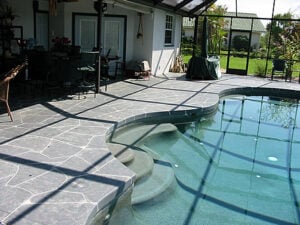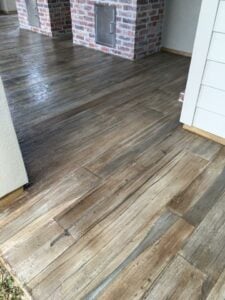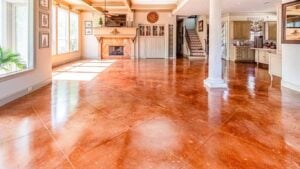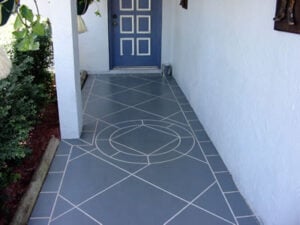Sustainability & Eco-Friendly Decorative Concrete Options in Sarasota
Explore our featured Decorative Concrete Contractors in Sarasota
Sarasota’s concrete industry is embracing sustainability and eco-friendly options, offering innovative solutions for decorative concrete that are both aesthetically pleasing and environmentally responsible. Here’s an overview of the eco-friendly decorative concrete options available in Sarasota:
Eco-Friendly Coatings
Bio-Based Epoxies and Polyurethanes
These coatings are derived from renewable resources such as plant oils and sugars, offering a sustainable alternative to traditional petroleum-based products. They provide durability and chemical resistance while significantly reducing volatile organic compounds (VOCs) and environmental impact.
Water-Based Sealers
Low in VOCs, water-based sealers are an environmentally conscious choice for protecting concrete floors. They offer effective protection while minimizing air pollution and potential health risks associated with harmful chemicals.
Polyaspartic Coatings
With higher solid content and lower VOC emissions, polyaspartic coatings strike a balance between performance and environmental responsibility. Some products, like Floor Shield’s 100% polyaspartic concrete coating, are California air-compliant, demonstrating a commitment to eco-friendly formulations.
Sustainable Concrete Techniques
Polished Concrete with Low-VOC Sealers
This option combines the durability of traditional concrete with environmentally friendly sealers, enhancing indoor air quality and aligning with green building standards. It’s an excellent choice for those who prefer the look of concrete but want a more sustainable option.
Shellcrete
Some Sarasota Decorative Concrete Contractors offer Shellcrete, an innovative blend of traditional concrete mixed with locally sourced crushed shells. This eco-friendly option repurposes natural materials, reducing the need for additional resources while creating a unique, coastal aesthetic.
Decorative Techniques
Stamped Concrete
Several Sarasota Decorative Concrete Contractors specialize in stamped concrete, which can mimic the appearance of natural materials like stone, brick, or wood. This technique allows for creative designs while potentially using more eco-friendly concrete mixtures and sealers.
Staining and Overlays
Some Sarasota Decorative Concrete Contractors offer staining and decorative overlays as environmentally conscious ways to rejuvenate existing concrete surfaces. These techniques can transform plain concrete without the need for complete replacement, reducing waste and resource consumption.
Benefits of Eco-Friendly Concrete Options
- Improved Indoor Air Quality: Low-VOC products contribute to healthier living and working environments.
- Durability: Many eco-friendly options offer comparable or superior durability to traditional concrete coatings.
- Resource Conservation: Techniques like Shellcrete and overlays repurpose materials or extend the life of existing concrete, reducing the demand for new resources.
- Aesthetic Versatility: Eco-friendly options don’t compromise on design possibilities, offering a wide range of colors, textures, and patterns.
Conclusion
Sarasota’s concrete industry is actively embracing sustainability, offering homeowners and businesses eco-friendly decorative concrete options that don’t sacrifice quality or aesthetics. From innovative coatings to creative techniques using recycled materials, these sustainable solutions are paving the way for a greener future in construction and design.
Green Benefits of Decorative Concrete in Sarasota
Decorative concrete in Sarasota offers numerous environmental benefits, making it an increasingly popular choice for eco-conscious homeowners and businesses. Here are the key green benefits of using decorative concrete in the Sunshine State:
Reduced Carbon Emissions
Decorative concrete significantly reduces carbon emissions compared to traditional paving materials. Its production and transportation require less energy, as it’s typically made from locally sourced materials. This lower carbon footprint aligns with Sarasota’s efforts to combat climate change and promote sustainable construction practices.
Improved Water Management
In Sarasota’s coastal areas, effective stormwater management is crucial. Decorative concrete, particularly permeable options, allows rainwater to permeate through the surface and into the ground. This reduces runoff, helps prevent erosion, and improves water quality by naturally filtering pollutants. It’s especially beneficial in mitigating issues related to harmful algal blooms that can affect Sarasota’s delicate ecosystems.
Heat Island Effect Reduction
Sarasota’s hot climate makes heat management a priority. Decorative concrete, especially lighter-colored varieties, reflects sunlight and absorbs less heat compared to materials like asphalt. This reflective property helps reduce the urban heat island effect, potentially lowering cooling costs for nearby buildings and creating more comfortable outdoor spaces.
Resource Conservation
Longevity and Durability: Decorative concrete is exceptionally durable, often lasting for decades with proper maintenance. This longevity reduces the need for frequent replacements, conserving resources and minimizing waste.
Use of Recycled Materials: Many decorative concrete mixes incorporate recycled materials such as fly ash, ground blast furnace slag, and silica fume. This practice repurposes industrial byproducts, reducing landfill waste and the demand for new raw materials.
Improved Indoor Air Quality
For interior applications, decorative concrete contributes to better indoor air quality. It emits fewer volatile organic compounds (VOCs) compared to many other flooring options. This is particularly beneficial in Sarasota’s humid climate, where indoor air quality can significantly impact health and comfort.
Energy Efficiency
The thermal mass of concrete can help regulate indoor temperatures, potentially reducing energy costs for heating and cooling. In Sarasota’s climate, this property can be especially beneficial during hot summer months, contributing to overall energy efficiency in buildings.
Low Maintenance Requirements
Decorative concrete requires minimal maintenance compared to other materials. This reduces the need for chemical cleaners and frequent replacements, further minimizing its environmental impact over time.
Versatility and Aesthetics
While not directly an environmental benefit, the versatility of decorative concrete allows it to mimic the appearance of natural materials like stone or wood. This eliminates the need to harvest these resources, indirectly contributing to conservation efforts.
In conclusion, decorative concrete offers Sarasota residents and businesses an environmentally responsible option that doesn’t compromise on aesthetics or functionality. Its ability to address specific environmental challenges faced in Sarasota, such as water management and heat reduction, makes it an excellent choice for those looking to create beautiful, sustainable spaces.
Using Recycled Materials in Decorative Concrete in Sarasota
The use of recycled materials in decorative concrete has gained significant traction in Sarasota, offering both environmental benefits and unique aesthetic possibilities. This trend aligns with the state’s sustainability goals and provides innovative solutions for construction and landscaping projects.
Types of Recycled Materials Used
Recycled Concrete Aggregate (RCA)
Recycled concrete aggregate is one of the most commonly used recycled materials in decorative concrete applications in Sarasota. It’s produced by crushing demolished concrete structures and processing the material to create a new aggregate. This recycled product can be used in various decorative concrete applications, including:
- Driveways
- Landscaping features
- Drain fields
- Construction entrances
Crushed Asphalt
Similar to RCA, crushed asphalt from demolished roads and parking lots is being repurposed for use in decorative concrete projects. It provides an excellent base material for synthetic turf installations and other landscaping applications.
Benefits of Using Recycled Materials
Environmental Impact
Using recycled materials in decorative concrete significantly reduces waste in landfills and preserves natural resources. This practice aligns with Sarasota’s statewide recycling goal of 75%.
Cost-Effectiveness
Recycled concrete and asphalt are often more affordable than virgin materials, making them an attractive option for both contractors and homeowners.
Durability
Despite being recycled, these materials offer comparable or even superior durability to traditional concrete in many applications.
Applications in Sarasota
Permeable Pavers
In Sarasota, where water management is crucial, permeable pavers made with recycled materials are gaining popularity. The Palm Beach Zoo’s entryway project showcases the use of permeable pavers combined with 100% recycled concrete aggregate in sculpted walls and water features.
Decorative Landscaping
Recycled concrete is being used creatively in landscaping projects across Sarasota. It can be shaped and sized to fit specific project requirements, making it ideal for creating unique decorative elements.
Synthetic Turf Base
Crushed recycled concrete is an excellent base material for synthetic turf installations, providing good drainage and long-term stability.
Considerations and Limitations
While recycled materials offer numerous benefits, there are some considerations to keep in mind:
- Color Variations: Recycled concrete may have cementitious particles that could affect the color of decorative concrete, especially in colored applications.
- Absorption: The porous nature of recycled concrete can make it more absorptive, which may be a concern in certain applications, particularly in areas prone to staining.
Conclusion
The use of recycled materials in decorative concrete is a growing trend in Sarasota, offering a sustainable and cost-effective alternative to traditional materials. As the state continues to focus on environmental conservation and innovative construction practices, we can expect to see more creative applications of recycled materials in decorative concrete projects across Sarasota.
Energy Efficiency of Concrete Flooring in Sarasota
Concrete flooring offers significant energy efficiency benefits for homes and buildings in Sarasota, making it an excellent choice for the state’s unique climate and energy needs.
Thermal Mass Properties
Concrete floors possess high thermal mass, allowing them to absorb, store, and slowly release heat. This property is particularly advantageous in Sarasota’s climate:
- In summer, concrete floors remain cool during the day, reducing the need for air conditioning.
- During cooler periods, concrete floors can absorb heat from direct sunlight and release it slowly at night, helping to regulate indoor temperatures.
Energy Savings
The thermal mass properties of concrete flooring contribute to energy savings in several ways:
- Reduced reliance on HVAC systems, leading to lower utility costs.
- Natural temperature regulation, decreasing the need for heating and cooling.
- Potential for up to 50% reduction in heating energy consumption when combined with proper insulation.
Passive Solar Design
Concrete floors are ideal for passive solar home designs in Sarasota:
- They absorb heat from direct sunlight entering through windows during cooler months.
- In summer, when properly shielded from the sun, they help keep the house cool.
Radiant Heating and Cooling
Concrete floors work well with energy-efficient radiant heating systems:
- They can be used for both heating in winter and cooling in summer when paired with chilled water systems.
- This approach improves air quality by eliminating the need for forced air systems that can circulate dust and pollutants.
Additional Energy Efficiency Benefits
- Light Reflection: Polished concrete flooring reflects light well, reducing the need for artificial lighting during daylight hours.
- Low Maintenance: Concrete floors require minimal upkeep, reducing energy and resource consumption associated with cleaning and maintenance.
- Longevity: The durability of concrete flooring means less frequent replacement, conserving energy and resources over time.
Environmental Impact
Choosing concrete flooring in Sarasota aligns with sustainability goals:
- Reduced carbon footprint due to lower energy consumption for heating and cooling.
- Locally sourced materials, minimizing transportation-related emissions.
- No emission of volatile organic compounds (VOCs), contributing to better indoor air quality.
In conclusion, concrete flooring provides an energy-efficient and environmentally friendly option for Sarasota’s homes and buildings. Its thermal mass properties, compatibility with passive solar design, and potential for significant energy savings make it an ideal choice for those looking to reduce their energy consumption and environmental impact.

From Drab to Fab: Custom Decorative Concrete Flooring Makeovers in Sarasota
Transforming drab concrete floors into fabulous spaces involves several techniques and materials, offering a wide range of design possibilities. Here’s how you can achieve a

How to Maintain Your Decorative Concrete Pool Deck in Sarasota
Maintaining a decorative concrete pool deck in Sarasota involves several key steps to ensure it remains durable and visually appealing. Here are some effective methods

Decorative Concrete Sealing in Sarasota: Protecting Your Investment
Decorative concrete sealing in Sarasota is a crucial step in protecting your investment and enhancing the beauty of your concrete surfaces. Here’s why it’s essential:

Sarasota Polished Concrete Floors Cost
Polished concrete floors in Sarasota are a cost-effective and durable flooring option, but understanding the pricing breakdown is essential for budgeting your project. Here’s what

How to Maintain and Care for Your Custom Decorative Concrete Floors in Sarasota
Maintaining and caring for your custom decorative concrete floors in Sarasota is essential to ensure they remain beautiful and durable over time. Here are some

Stamped vs. Stained: Exploring Sarasota Decorative Concrete Resurfacing Options
Decorative concrete resurfacing Sarasota offers homeowners and businesses cost-effective ways to transform existing concrete surfaces. Two popular options are stamped and stained concrete. Let’s explore
